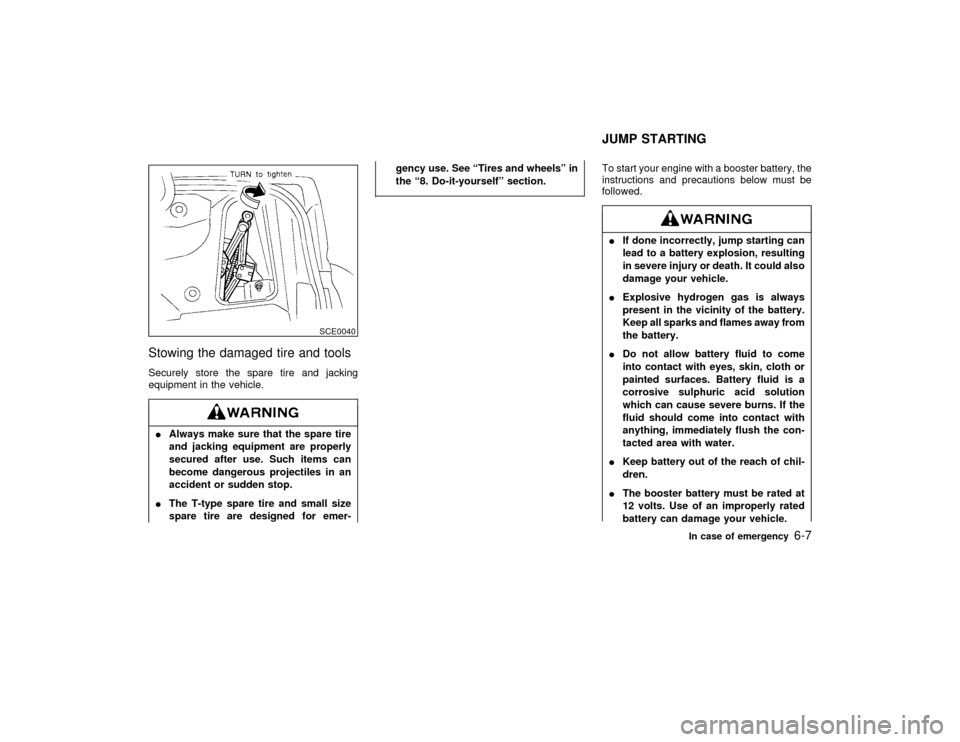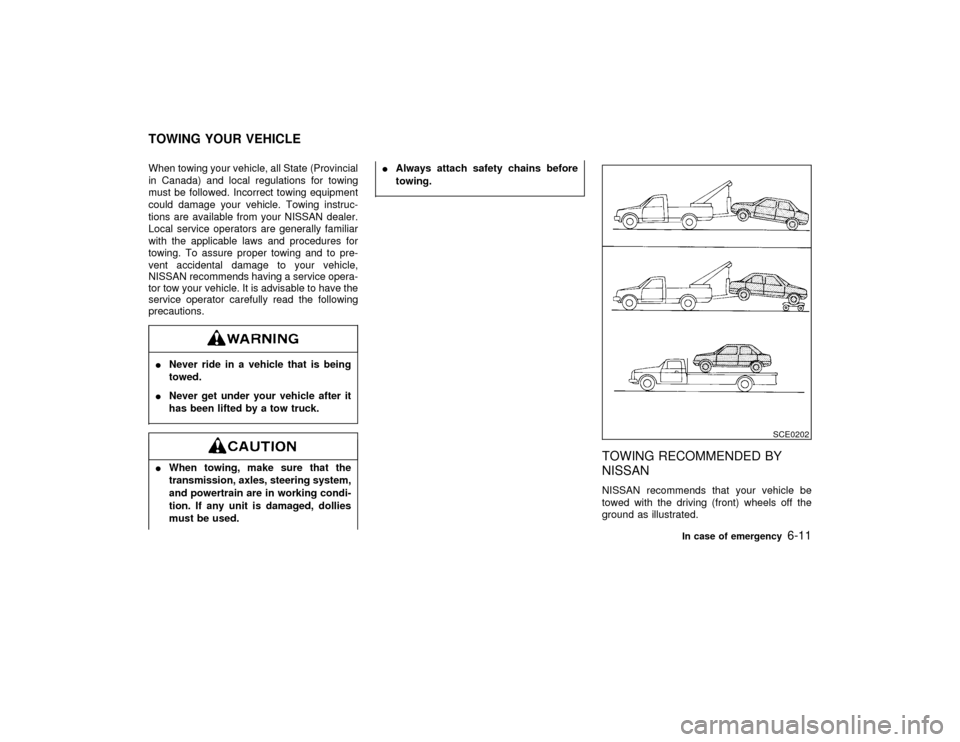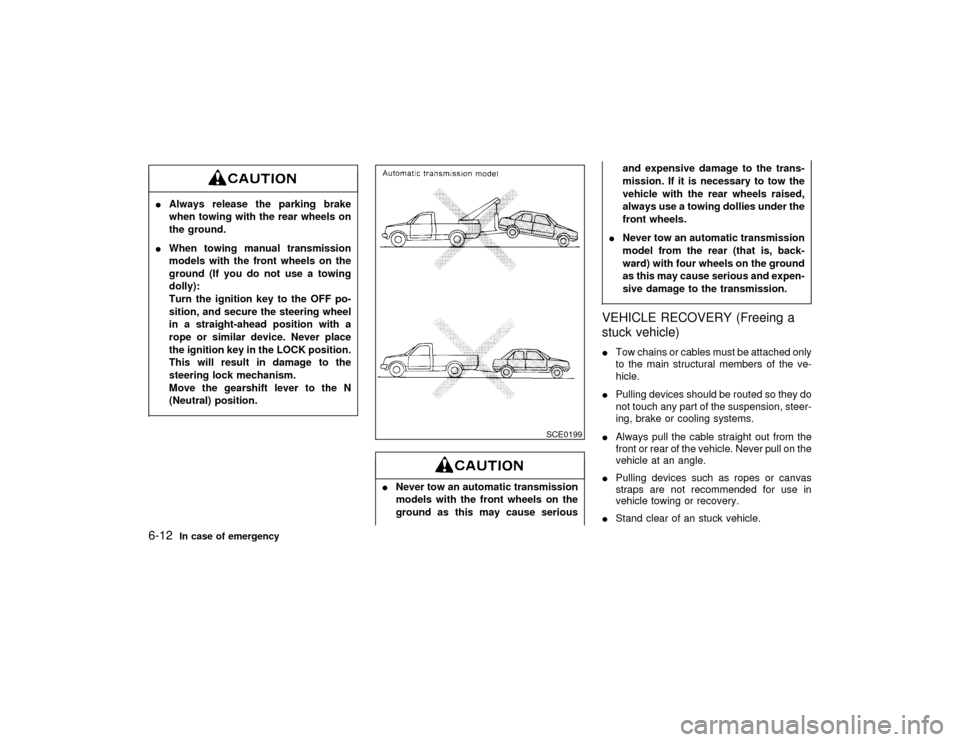Page 140 of 233
6 In case of emergencyFlat tire ...................................................................... 6-2
Changing a flat tire .................................................... 6-2
Jump starting............................................................. 6-7
Push starting ............................................................. 6-9If your vehicle overheats ......................................... 6-10
Towing your vehicle ................................................ 6-11
Towing recommended by NISSAN ......................... 6-11
Vehicle recovery (Freeing a stuck vehicle) ............. 6-12
Z
01.1.22/A32-D/V5.0
X
Page 146 of 233

Stowing the damaged tire and toolsSecurely store the spare tire and jacking
equipment in the vehicle.IAlways make sure that the spare tire
and jacking equipment are properly
secured after use. Such items can
become dangerous projectiles in an
accident or sudden stop.
IThe T-type spare tire and small size
spare tire are designed for emer-gency use. See ªTires and wheelsº in
the ª8. Do-it-yourselfº section.
To start your engine with a booster battery, the
instructions and precautions below must be
followed.IIf done incorrectly, jump starting can
lead to a battery explosion, resulting
in severe injury or death. It could also
damage your vehicle.
IExplosive hydrogen gas is always
present in the vicinity of the battery.
Keep all sparks and flames away from
the battery.
IDo not allow battery fluid to come
into contact with eyes, skin, cloth or
painted surfaces. Battery fluid is a
corrosive sulphuric acid solution
which can cause severe burns. If the
fluid should come into contact with
anything, immediately flush the con-
tacted area with water.
IKeep battery out of the reach of chil-
dren.
IThe booster battery must be rated at
12 volts. Use of an improperly rated
battery can damage your vehicle.
SCE0040
JUMP STARTING
In case of emergency
6-7
Z
01.1.22/A32-D/V5.0
X
Page 150 of 233

When towing your vehicle, all State (Provincial
in Canada) and local regulations for towing
must be followed. Incorrect towing equipment
could damage your vehicle. Towing instruc-
tions are available from your NISSAN dealer.
Local service operators are generally familiar
with the applicable laws and procedures for
towing. To assure proper towing and to pre-
vent accidental damage to your vehicle,
NISSAN recommends having a service opera-
tor tow your vehicle. It is advisable to have the
service operator carefully read the following
precautions.INever ride in a vehicle that is being
towed.
INever get under your vehicle after it
has been lifted by a tow truck.IWhen towing, make sure that the
transmission, axles, steering system,
and powertrain are in working condi-
tion. If any unit is damaged, dollies
must be used.IAlways attach safety chains before
towing.
TOWING RECOMMENDED BY
NISSANNISSAN recommends that your vehicle be
towed with the driving (front) wheels off the
ground as illustrated.
SCE0202
TOWING YOUR VEHICLE
In case of emergency
6-11
Z
01.1.22/A32-D/V5.0
X
Page 151 of 233

IAlways release the parking brake
when towing with the rear wheels on
the ground.
IWhen towing manual transmission
models with the front wheels on the
ground (If you do not use a towing
dolly):
Turn the ignition key to the OFF po-
sition, and secure the steering wheel
in a straight-ahead position with a
rope or similar device. Never place
the ignition key in the LOCK position.
This will result in damage to the
steering lock mechanism.
Move the gearshift lever to the N
(Neutral) position.
INever tow an automatic transmission
models with the front wheels on the
ground as this may cause seriousand expensive damage to the trans-
mission. If it is necessary to tow the
vehicle with the rear wheels raised,
always use a towing dollies under the
front wheels.
INever tow an automatic transmission
model from the rear (that is, back-
ward) with four wheels on the ground
as this may cause serious and expen-
sive damage to the transmission.
VEHICLE RECOVERY (Freeing a
stuck vehicle)ITow chains or cables must be attached only
to the main structural members of the ve-
hicle.
IPulling devices should be routed so they do
not touch any part of the suspension, steer-
ing, brake or cooling systems.
IAlways pull the cable straight out from the
front or rear of the vehicle. Never pull on the
vehicle at an angle.
IPulling devices such as ropes or canvas
straps are not recommended for use in
vehicle towing or recovery.
IStand clear of an stuck vehicle.
SCE0199
6-12
In case of emergency
Z
01.1.22/A32-D/V5.0
X